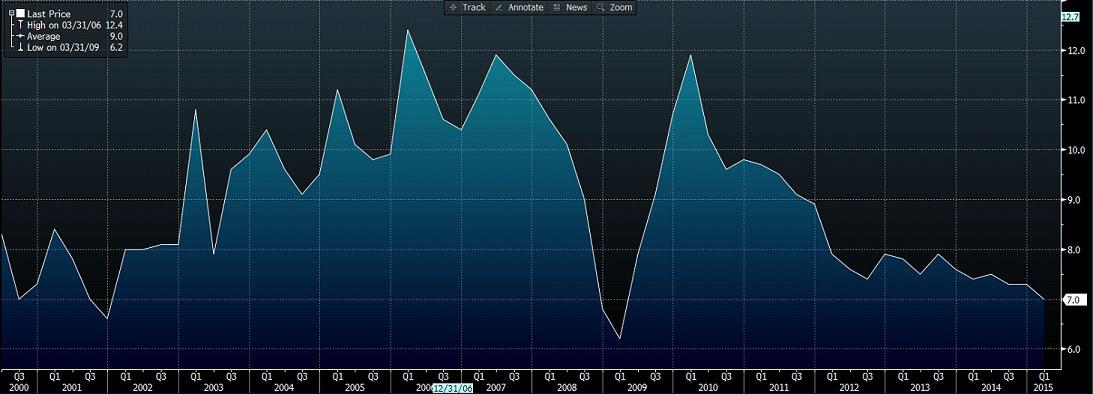The Peoples Bank of China (PBOC) announced yesterday, that they would be loosening the reserve requirement ratio (RRR) for all financial institutions by 100 basis points. The regulatory cut potentially increases liquidity within Chinese markets and analysts at Goldman Sachs estimate the total capital release to be in the range of 1.2 trillion RMB. Lacklustre Chinese GDP, softening activity rates, and FX outflows have sought to drain the local market of liquidity and are the likely drivers behind the move.
News of the Chinese stimulus caused the swap curve to steepen and rates to fall by up to 10bps with the 7-day repo rate also falling to 2.81%. It is likely that further steepness to the swap curve is yet to come and that, with the additional liquidity within the market, sequential growth should eventually lift. Chinese GDP is likely to see more favourable results moving into Q2, 2015, as looser quantitative policies and a potentially resurgent US economy drive growth. The fading out of the effects of China’s seasonal anti-corruption campaign, which is strongest in the early parts of the year, is also likely to provide additional growth.
Although the RRR cut signals the PBOC’s resolve to support the economy, economic data will dictate whether further stimulus is needed. Despite some analysts, promoting the view that further cuts in the range of 150bps to RRR are probable, it will largely depend on Q2’s GDP result. It is likely that the PBOC will give the policy change time to provide its full impact to the market.
Chinese GDP YoY
The impact of the additional liquidity within China’s economy is likely to have several effects on Asian currencies, mostly positive. The full value of the RRR cuts is yet to be priced into currency markets and this was mainly due to surprise over the value of the cuts. It is therefore probable that some regional currencies will appreciate over the coming days.
The Hong Kong dollar, in particular, is likely to benefit from increased southbound capital flows as money continues to flow into the Hang Seng. The HKD is likely to trade near the upper limit within the convertibility range causing the Hong Kong Monetary Authority to continue intervention through the purchase of USD.
The Australian Dollar is also likely to receive significant benefit from continued stimulus in China. Australian economic growth has suffered recently due to a downgrade in Chinese growth and subsequent reduction in commodity demand. Additional capital within the Chinese economy is likely to be positive for the AUD and Australian mining stocks.
Arguably, the net effect of any RRR cut is difficult to forecast and the market will need to view the economic data in Q2, 2015, before pricing in the probability of further stimulus by the PBOC. Any subsequent economic weakness is likely to bring substantive and decisive action by China to support the economy.
Risk Warning: Any form of trading or investment carries a high level of risk to your capital and you should only trade with money you can afford to lose. The information and strategies contained herein may not be suitable for all investors, so please ensure that you fully understand the risks involved and you are advised to seek independent advice from a registered financial advisor. The advice on this website is general in nature and does not take into account your objectives, financial situation or needs. You should consider whether the advice is suitable for you and your personal circumstances. The information in this article is not intended for residents of New Zealand and use by any person in any country or jurisdiction where such distribution or use would be contrary to local law or regulation. Knight Review is not a registered financial advisor and in no way intends to provide specific advice to you in any form whatsoever and provide no financial products or services for sale. As always, please take the time to consult with a registered financial advisor in your jurisdiction for a consideration of your specific circumstances.
Recommended Content
Editors’ Picks
EUR/USD retreats below 1.0700 as USD rebounds

EUR/USD lost its traction and retreated slightly below 1.0700 in the American session, erasing its daily gains in the process. Following a bearish opening, the US Dollar holds its ground and limits the pair's upside ahead of the Fed policy meeting later this week.
USD/JPY recovers toward 157.00 following suspected intervention

USD/JPY recovers ground and trades above 156.50 after sliding to 154.50 on what seemed like a Japanese FX intervention. Later this week, the Federal Reserve's policy decisions and US employment data could trigger the next big action.
Gold holds steady above $2,330 to start the week

Gold fluctuates in a relatively tight channel above $2,330 on Monday. The benchmark 10-year US Treasury bond yield corrects lower and helps XAU/USD limit its losses ahead of this week's key Fed policy meeting.
Week Ahead: Bitcoin could surprise investors this week Premium

Two main macroeconomic events this week could attempt to sway the crypto markets. Bitcoin (BTC), which showed strength last week, has slipped into a short-term consolidation.
Five Fundamentals for the week: Fed fears, Nonfarm Payrolls, Middle East promise an explosive week Premium

Higher inflation is set to push Fed Chair Powell and his colleagues to a hawkish decision. Nonfarm Payrolls are set to rock markets, but the ISM Services PMI released immediately afterward could steal the show.
